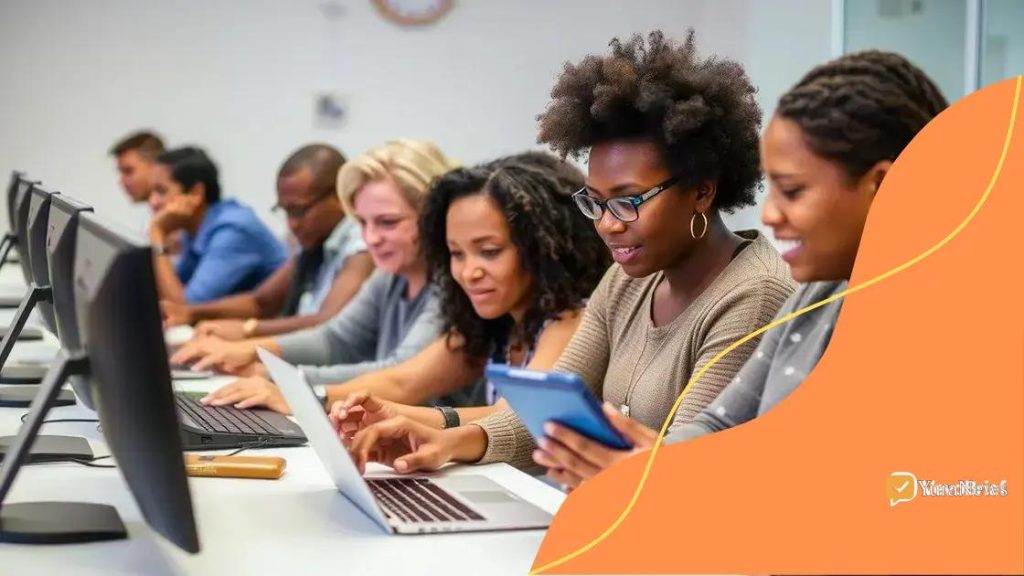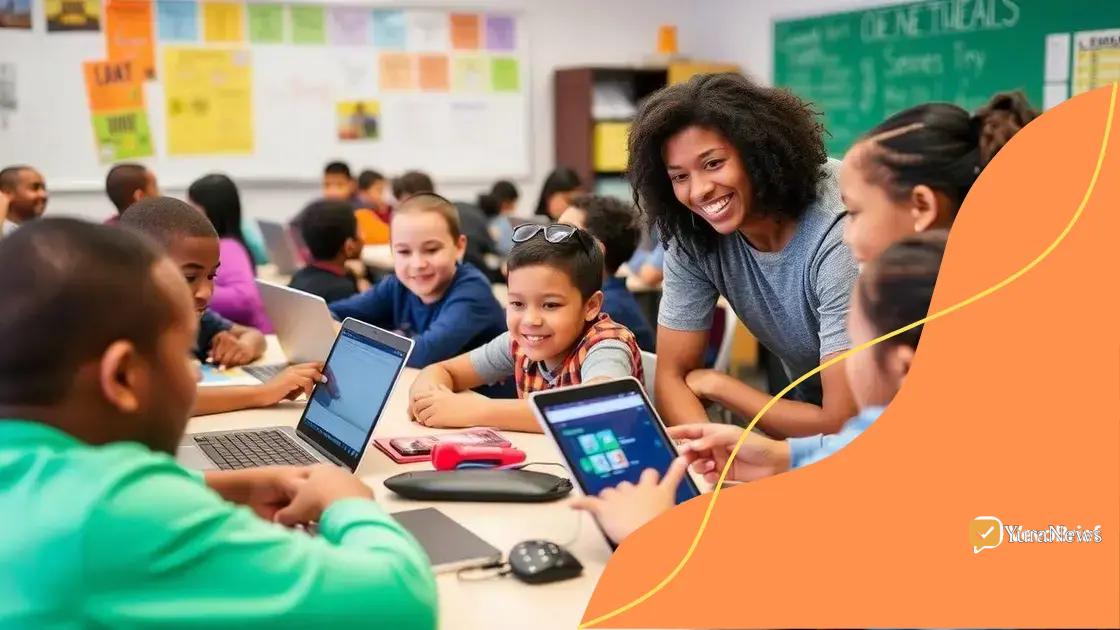Digital literacy efforts grow: empowering communities today

Anúncios
Digital literacy efforts grow to empower communities by enhancing access to information, improving job prospects, and fostering stronger social connections through targeted training and technology initiatives.
Digital literacy efforts grow as communities recognize the need for essential tech skills. But have you thought about how this impacts your everyday life? Let’s dive into its significance.
Anúncios
Understanding digital literacy
Understanding digital literacy is crucial in today’s tech-driven world. It’s not just about knowing how to use a computer or smartphone; it’s about effectively navigating the digital landscape for various tasks.
Digital literacy encompasses a range of skills. It includes using the internet for research, understanding online privacy, and communicating through digital platforms. With technology evolving rapidly, staying informed is more vital than ever.
Key Components of Digital Literacy
To grasp the essence of digital literacy, it’s helpful to break it down into key components:
Anúncios
- Information literacy: The ability to locate and evaluate information.
- Communication skills: Understanding how to interact in digital spaces.
- Technical proficiency: Knowing how to use digital tools effectively.
- Digital ethics: Being aware of online responsibilities and safety.
These skills enhance personal and professional growth. For example, employers increasingly seek candidates with strong digital literacy skills. Individuals who can efficiently navigate online platforms often find better opportunities.
Benefits of Being Digitally Literate
Being digitally literate comes with many advantages. It not only aids in job searching but also empowers individuals to:
- Access information quickly and efficiently.
- Communicate effectively in a globalized world.
- Contribute to community engagement and participation.
Ultimately, understanding digital literacy helps bridge the gap between technology and society. It’s about integrating these skills into daily life, ensuring everyone can connect and thrive in our digital age.
The importance of digital skills in today’s world
The importance of digital skills in today’s world cannot be overstated. As technology continues to evolve, having a firm grasp on these skills is essential for personal and professional advancement.
Today, almost every job requires some degree of digital proficiency. This includes everything from creating presentations to managing online communications. Without these skills, individuals may struggle to keep up in the competitive job market.
Why Digital Skills Matter
Understanding digital skills opens up a world of opportunities. For instance, those with these skills can:
- Access a wider range of job opportunities.
- Enhance their ability to collaborate effectively in diverse teams.
- Improve their problem-solving abilities through technology.
Moreover, digital literacy allows individuals to stay informed about current events and technological advancements. The internet is filled with valuable information that enhances learning and personal growth.
Impact on Daily Life
The influence of digital skills extends beyond the workplace. In daily life, being digitally literate can simplify tasks. For example, individuals can manage personal finances through apps, find health information online, and connect with others through social media.
In communities, fostering digital literacy leads to greater engagement in civic life. People can participate in discussions, advocate for changes, and contribute to societal improvements through technology. This collective involvement strengthens community bonds.
Successful digital literacy programs

Successful digital literacy programs play a vital role in equipping individuals with the necessary skills to thrive in a digital world. These programs are designed to cater to various audiences, from students to seniors, ensuring that everyone has access to essential training.
When implemented effectively, digital literacy programs can significantly impact communities. They not only teach important skills but also foster confidence and a sense of belonging in participants. Many organizations have successfully launched programs that provide hands-on training in various areas.
Key Elements of Successful Programs
There are several key elements that contribute to the success of digital literacy programs. These include:
- Tailored content: Programs should address the specific needs of their target audience.
- Experienced instructors: Knowledgeable educators enhance the learning experience.
- Accessible resources: Providing materials that participants can easily use is crucial.
Another important aspect is the integration of real-world applications. For instance, participants may engage in projects that involve using technology for everyday tasks. This practical approach helps link theory to practice.
Examples of Successful Programs
Many organizations have pioneered successful digital literacy programs. For example, public libraries often offer workshops that teach basic computer skills. These workshops usually cater to all ages, creating inclusive learning environments. Similarly, nonprofit organizations frequently host classes that focus on specific tools, like spreadsheets or presentation software.
Schools are also becoming more involved in enhancing digital literacy. By incorporating technology into their curriculums, they help students develop necessary skills from a young age. This early exposure prepares them for future challenges in a tech-driven society.
How communities benefit from digital initiatives
Communities benefit from digital initiatives in numerous ways, making these efforts crucial for social and economic development. By leveraging technology, local organizations can enhance services, provide education, and foster connections.
One primary advantage is improved access to information. With digital resources, members can stay informed about local events, health services, and educational opportunities. This knowledge empowers residents to make better decisions.
Enhancing Education through Digital Access
Educational programs that incorporate digital tools can significantly impact community learning. For example, online classes allow individuals to gain new skills. These programs can include:
- Virtual tutoring for students of all ages.
- Workshops that teach practical skills, such as coding or graphic design.
- Access to online libraries and resources for research.
By making these resources available, communities can close the education gap and create more opportunities for all residents.
Strengthening Community Connections
In addition, digital initiatives foster stronger community ties. Social media and online forums enable residents to connect and collaborate. This interaction can lead to:
- Organized local events that bring people together.
- Support networks for individuals in need.
- Collaborative projects that improve community spaces.
As people come together online, they can share experiences and ideas, making the community more cohesive.
Furthermore, local businesses benefit as they connect with customers through digital marketing. By reaching a larger audience, they can enhance their services and contribute to the community’s economy.
Challenges to digital literacy and potential solutions
Challenges to digital literacy are prevalent in many communities, hindering individuals from fully participating in the digital age. Addressing these obstacles is essential for ensuring everyone has equal access to technology and its benefits.
One major challenge is limited access to technology. In underserved areas, people may not have computers or reliable internet connections. This lack of access can create a significant barrier to learning basic digital skills.
Common Obstacles
Besides access, there are other hurdles that individuals face when trying to improve their digital literacy:
- Insufficient training resources: Many programs lack adequate materials and qualified instructors.
- Fear of technology: Some individuals may feel intimidated by digital tools and shy away from using them.
- Language barriers: Non-native speakers may struggle with resources that are not available in their language.
These obstacles can lead to frustration and a sense of exclusion from the digital world.
Potential Solutions
Creating effective solutions involves a collaborative approach and innovative thinking. Here are some potential strategies to enhance digital literacy:
- Community workshops: Local organizations can host free workshops that teach essential skills, ensuring they cater to various skill levels.
- Mobile technology units: Providing mobile access to technology in underserved neighborhoods can bridge the gap.
- Partnerships with schools: Collaborating with educational institutions can help integrate digital skills training into existing curriculums.
Additionally, using online resources to reach a broader audience can help overcome barriers. Offering classes in multiple languages and using simple language can make learning more inclusive.
FAQ – Frequently Asked Questions about Digital Literacy Efforts
Why is digital literacy important in today’s society?
Digital literacy is crucial as it enables individuals to access information, communicate effectively, and participate in the digital economy.
What challenges do communities face in achieving digital literacy?
Common challenges include limited access to technology, insufficient training resources, and language barriers.
How can digital literacy initiatives improve community engagement?
By offering workshops and training sessions, communities can connect residents, foster collaboration, and improve social ties.
What solutions can enhance digital literacy in underserved areas?
Solutions include providing mobile tech units, creating tailored education programs, and leveraging online resources to reach a wider audience.